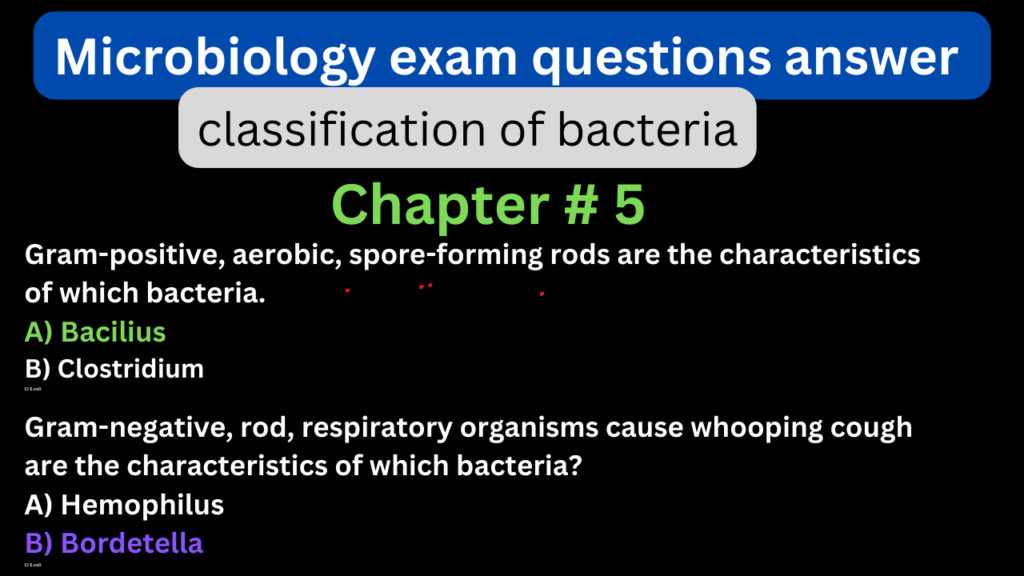Here are the most important Microbiology exam questions answer pdf chapter 5 – Classification of medically important bacteria.
Question 1: Which of the following bacterial groups possess a thick layer of peptidoglycan in their cell walls, making them Gram-positive?
A) Proteobacteria
B) Cyanobacteria
C) Firmicutes
D) Spirochetes
Answer: C) Firmicutes
Question 2: Bacteria with a thin layer of peptidoglycan in their cell walls, which stains pink in Gram staining, are referred to as:
A) Gram-negative
B) Gram-positive
C) Gram-neutral
D) Gram-variable
Answer: A) Gram-negative
Question 3: The bacterial group that includes species with diverse shapes such as cocci, bacilli, and spiral forms, and possess an outer membrane in their cell wall structure, is:
A) Actinobacteria
B) Firmicutes
C) Proteobacteria
D) Cyanobacteria
Answer: C) Proteobacteria
Question 4: Which bacterial phylum comprises organisms that are often found in extreme environments, have a unique cell wall structure, and include the genus Thermus?
A) Chloroflexi
B) Thermotogae
C) Aquificae
D) Deinococcus-Thermus
Answer: D) Deinococcus-Thermus
Question 5: The bacterial group known for their branching filaments, often forming complex mycelium-like structures, and having a high G+C content in their DNA, is:
A) Cyanobacteria
B) Spirochetes
C) Actinobacteria
D) Chlamydiae
Answer: C) Actinobacteria
Question 6: Which of the following bacterial groups is characterized by a unique cell wall structure containing pseudomurein, and they are often found in extreme environments like hot springs and hydrothermal vents?
A) Firmicutes
B) Spirochetes
C) Crenarchaeota
D) Thaumarchaeota
Answer: C) Crenarchaeota
Question 7: The bacterial group responsible for nitrogen fixation and often found in root nodules of leguminous plants belongs to which phylum?
A) Cyanobacteria
B) Proteobacteria
C) Spirochetes
D) Chlamydiae
Answer: B) Proteobacteria
Question 8: The genus Borrelia which causes diseases like Lyme disease is a member of which bacterial group?
A) Firmicutes
B) Actinobacteria
C) Spirochetes
D) Thermotogae
Answer: C) Spirochetes
Question 9: Which bacterial phylum includes species that lack a peptidoglycan cell wall and are characterized by a unique cell membrane composed of ether-linked lipids?
A) Planctomycetes
B) Fusobacteria
C) Bacteroidetes
D) Chlamydiae
Answer: A) Planctomycetes
Question 10: The bacterial group responsible for many sexually transmitted infections and includes the genus Chlamydia is:
A) Firmicutes
B) Actinobacteria
C) Spirochetes
D) Chlamydiae
Answer: D) Chlamydiae
Question 11: Bacteria belonging to the phylum Cyanobacteria are known for:
A) Having no cell walls
B) Being Gram-negative
C) Performing photosynthesis
D) Being thermophilic
Answer: C) Performing photosynthesis
Question 12: The bacterial phylum Spirochaetes is characterized by:
A) Formation of endospores
B) Helical or spiral-shaped cells
C) Being acidophilic
D) Lack of cell walls
Answer: B) Helical or spiral-shaped cells
Question 13: Which bacterial group is responsible for causing tuberculosis and leprosy?
A) Actinobacteria
B) Cyanobacteria
C) Chlamydiae
D) Thermotogae
Answer: A) Actinobacteria
Question 14: The bacterial phylum Chloroflexi includes species that are commonly found in:
A) Extreme thermophilic environments
B) Oxygen-rich environments
C) Anaerobic environments
D) Saline environments
Answer: A) Extreme thermophilic environments
Question 15: Which bacterial phylum includes species responsible for producing methane as a metabolic byproduct?
A) Bacteroidetes
B) Thermotogae
C) Firmicutes
D) Euryarchaeota
Answer: D) Euryarchaeota
Question 16: Bacteria of the phylum Fusobacteria are often associated with infections involving:
A) Gastrointestinal tract
B) Respiratory tract
C) Urinary tract
D) Oral cavity
Answer: D) Oral cavity
Question 17: Which bacterial group includes the genus Mycoplasma known for their lack of a cell wall?
A) Firmicutes
B) Actinobacteria
C) Spirochetes
D) Tenericutes
Answer: D) Tenericutes
Question 18: The bacterial group Planctomycetes is distinct for possessing:
A) Intracellular membrane compartments
B) Extremely thick cell walls
C) Multiple flagella
D) Photosynthetic pigments
Answer: A) Intracellular membrane compartments
Question 19: The phylum Aquificae includes thermophilic bacteria that generate energy through:
A) Photosynthesis
B) Methanogenesis
C) Sulfur oxidation
D) Hydrogen oxidation
Answer: D) Hydrogen oxidation
Question 20: The bacterial phylum Bacteroidetes is commonly found in which type of environments?
A) Acidic hot springs
B) Extreme halophilic environments
C) Marine and freshwater habitats
D) Deep-sea hydrothermal vents
Answer: C) Marine and freshwater habitats
Question 21: Gram-positive, cocci, cause abscesses of skin are the characteristics of which bacteria.
A) Staphylococcus
B) Streptococcus
C) E.coli
Question 22: Gram-positive, aerobic, spore-forming rods are the characteristics of which bacteria.
A) Bacilius
B) Clostridium
C) E.coli
Question 23: Gram-negative, cocci, cause gonorrhea are the characteristics of which bacteria?
A) Staphylococcus
B) Neisseria
C) E.coli
Question 24: Gram-negative, rod, respiratory organisms cause whooping cough are the characteristics of which bacteria?
A) Hemophilus
B) Bordetella
C) E.coli
Question 25: Gram-negative, rod, enteric related cause typhoid fever are the characteristics of which bacteria?
A) Shagella
B) Salmonella
C) Proteus
Question 26: Gram-negative, curved shape, cause peptic ulcer, gastric ulcer are the characteristics of which bacteria?
A) Campylobactor
B) Helicobacter
C) E.coli
Question 27: Obligatory intracellular parasites, cause Q-fever, and typhus are the characteristics of which bacteria?
A) Rickettsia
B) Chlamydia
C) None
Question 28: Wallless cells, cause Pneumonia are the characteristics of which bacteria?
A) Mycoplasma
B) Treponema
C) Leptospira
